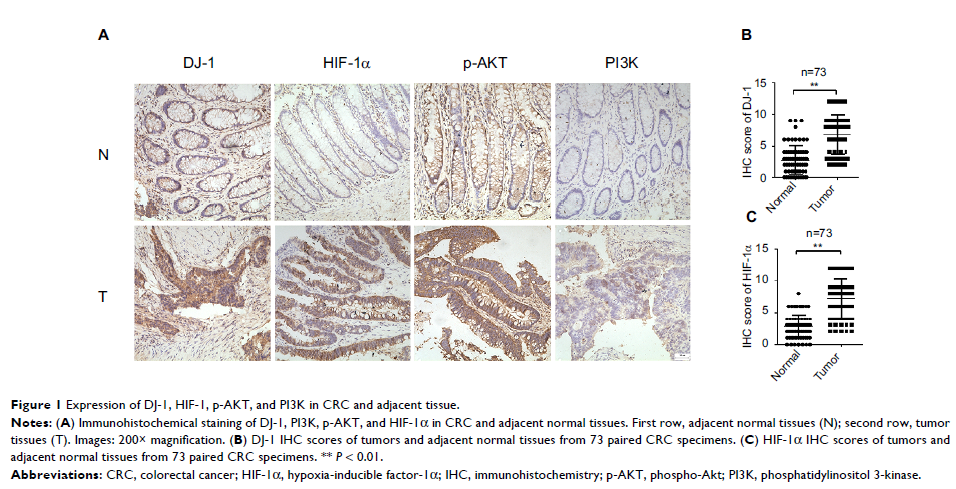108384
论文已发表
注册即可获取德孚的最新动态
IF 收录期刊
- 3.4 Breast Cancer (Dove Med Press)
- 3.2 Clin Epidemiol
- 2.6 Cancer Manag Res
- 2.9 Infect Drug Resist
- 3.7 Clin Interv Aging
- 5.1 Drug Des Dev Ther
- 3.1 Int J Chronic Obstr
- 6.6 Int J Nanomed
- 2.6 Int J Women's Health
- 2.9 Neuropsych Dis Treat
- 2.8 OncoTargets Ther
- 2.0 Patient Prefer Adher
- 2.2 Ther Clin Risk Manag
- 2.5 J Pain Res
- 3.0 Diabet Metab Synd Ob
- 3.2 Psychol Res Behav Ma
- 3.4 Nat Sci Sleep
- 1.8 Pharmgenomics Pers Med
- 2.0 Risk Manag Healthc Policy
- 4.1 J Inflamm Res
- 2.0 Int J Gen Med
- 3.4 J Hepatocell Carcinoma
- 3.0 J Asthma Allergy
- 2.2 Clin Cosmet Investig Dermatol
- 2.4 J Multidiscip Healthc

DJ-1 通过 PI3K-AKT 通路调节 HIF-1α 表达,促进缺氧条件下人结肠癌细胞的存活
Authors Zheng H, Zhou C, Lu X, Liu Q, Liu M, Chen G, Chen W, Wang S, Qiu Y
Received 23 April 2018
Accepted for publication 13 July 2018
Published 16 October 2018 Volume 2018:10 Pages 4615—4629
DOI https://doi.org/10.2147/CMAR.S172008
Checked for plagiarism Yes
Review by Single-blind
Peer reviewers approved by Dr Colin Mak
Peer reviewer comments 3
Editor who approved publication: Professor Nakshatri
Background: Protein/nucleic acid deglycase (DJ-1) and hypoxia-inducible
factor-1α (HIF-1α) play significant roles in the progression of various types
of cancer and are associated with the phosphatidylinositol 3-kinase (PI3K)
pathway. However, their functions in colorectal cancer (CRC) have not been identified.
The aim of this study was to analyze the putative signaling pathway
encompassing DJ-1, PI3K, and HIF-1α in a series of CRC tissues and cell lines.
Purpose: This study aimed at exploring the expression
status of DJ-1 in colon cancer and its role in survival of cancer cell lines.
Methods: The expression and localization of DJ-1, PI3K-p110α,
phosphorylated Akt (p-AKT), and HIF-1α were determined by immunohistochemistry
in 73 resected CRC tissues. The effect of DJ-1 on cell activity was explored by
in vitro knockdown and overexpression experiments in SW480 and HT-29 cells. The
cells were treated with a PI3K inhibitor (LY294002 or wortmannin), and p-AKT
and HIF-1α protein expression were then analyzed. Apoptosis was analyzed by
flow cytometry. The expression levels of several HIF-1 target genes were
assessed under hypoxic conditions by reverse transcription-PCR and Western
blot. Xenograft tumor growth studies were conducted in DJ-1 knockdown or
overexpression cells.
Results: High DJ-1 expression was found in 68.49% (50/73) of
CRC tissues and associated with larger tumor size and advanced clinical stages.
DJ-1 expression was positively associated with PI3K-p110α, p-AKT, and HIF-1α
expression in CRC. HIF-1α and p-AKT protein levels were lower in SW480 and HT-29
cells with stable DJ-1 knockdown than in those with DJ-1 overexpression. PI3K
inhibitors almost completely blocked DJ-1-induced AKT phosphorylation. However,
the expression of HIF-1α was partially preserved after treatment with PI3K
inhibitors. We also show that DJ-1 is necessary for the transcriptional ability
of HIF-1α and CRC cell survival after hypoxic stress. Moreover, DJ-1 promoted
the growth of established tumor xenografts in nude mice.
Conclusion: Our findings are the first to show that DJ-1 is
overexpressed in CRC. We suggest a model in which DJ-1 mediates CRC cell
survival by regulating the PI3K-AKT-HIF-1α pathway.
Keywords: DJ-1,
hypoxia-inducible factor-1α, phosphatidylinositol 3-kinase, phosphorylated Akt,
colorectal cancer
